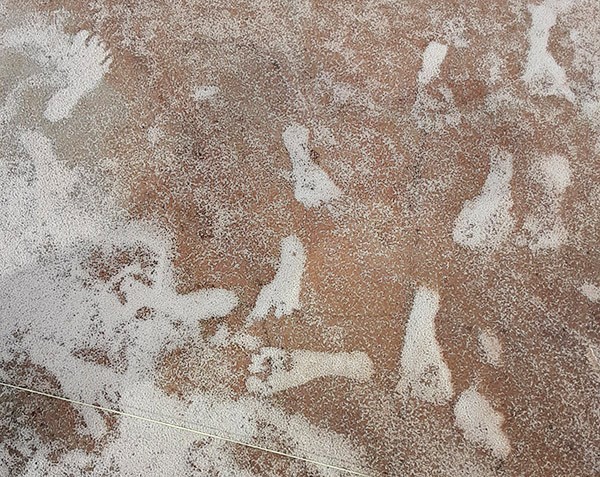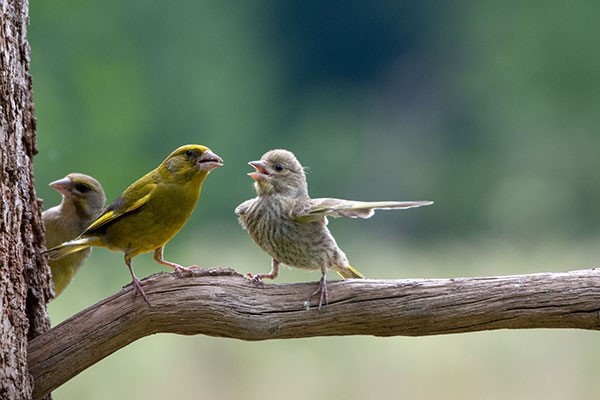Hello Nature readers, would you like to get this Briefing in your inbox free every day? Sign up here.

These footprints found in New Mexico are between 21,000 and 23,000 years old, and probably belonged to children and teenagers. (National Park Service)
Fossilized human footprints might be the oldest direct evidence that people lived in the Americas thousands of years earlier than thought — as early as 23,000 years ago. Researchers analysed pollen and sediment from the footprints and found that their ages matched estimates from 2021 that were based on the ages of seeds stuck in the fossils. The finding supports the idea that people skirted down the Pacific coast of the Americas after crossing the Bering land bridge, rather than waiting until ice-age glaciers retreated from inland routes. The timeline is also supported by indirect evidence, such as pendants carved from animal remains, but the footprints in New Mexico are special because they were undoubtedly made by people.
Associated Press | 3 min read
Read more: Ancient footprints could be oldest traces of humans in the Americas (Nature | 6 min read, from 2021, Nature paywall)
Reference: Science paper
Scientists in Poland are exploring the possibility of testing whether a woman has taken the abortion drugs mifepristone and misoprostol. The researchers say that their work is untainted by politics, but others worry that the technique could be used by prosecutors in Poland and other countries where abortion is, in most cases, illegal.
Nature | 7 min read
Bird-flu-resistant chickens have been created using CRISPR gene editing. When exposed to the flu virus, nine out of ten of the animals remained uninfected and didn’t pass the virus to other birds. Researchers modified a gene encoding a chicken protein that the virus needs to replicate. But this prompted the virus to start replicating using other proteins in the same family, which the researchers think could be addressed with more edits. “We must be careful not to facilitate adaptations of the virus that make it more dangerous than it [already] is,” says virologist and study co-author Wendy Barclay.
El País | 4 min read
Reference: Nature Communications paper
Features & opinion
Table of Contents
Large language models (LLMs), such as ChatGPT, could become regular assistants for writing manuscripts, peer-review reports and grant applications. These artificial-intelligence (AI) tools could change how scientists interrogate and summarize results, producing ‘papers on demand’ from experimental data and vastly expanding the scope of meta-analyses and reviews. But publishers worry that LLMs’ propensity to make up information might lead to a flood of error-strewn manuscripts — and possibly AI-assisted fakes. And because LLMs trawl Internet content without concern for bias, consent or copyright, their use is “automated plagiarism by design”, suggests cognitive scientist Iris van Rooij.
Nature | 11 min read
Each Nipah outbreak gives the deadly virus the chance to produce a strain that could spread more effectively — and there are no vaccines or treatments available yet. Smart policy changes can help to quell the risk of a pandemic, says epidemiologist Thekkumkara Surendran Anish. An early detection system in countries likely to have Nipah virus reservoirs in fruit bats, he explains. Public-awareness campaigns aimed at stopping behaviours that could bring people into contact with bat saliva can also help to prevent spillover of the virus.
Nature | 5 min read
The influence of statistician Calyampudi Radhakrishna Rao can be partly appreciated by perusing the many advances that carry his name: the Cramér–Rao inequality, used to estimate unknown parameters of a statistical population, such as the average blood-pressure reduction caused by a new drug. Another is the Rao–Blackwell theorem, an algorithm that derives rules for making such estimations. A third is the Fisher–Rao distance — a metric for the dissimilarity between two probability distributions — which gave rise to ‘information geometry’, a technique that enables information to be extracted from data sets with many variables. Rao, who published seminal papers while he was just in his twenties, has died aged 102.
Nature | 5 min read
Image of the week

The shortlist for this year’s Comedy Wildlife Photography Awards includes this young greenfinch (Chloris chloris) seeming to berate an elder in the Bialowieza Forest in Poland. (Forbes | 6 min read) (Jacek Stankiewicz/Comedy Wildlife Photography Awards 2023)
For those of us following Fat Bear Week, the annual face-off between the big, beautiful brown bears of Katmai National Park in Alaska: we have a winner! A big beauty named 128 Grazer came out on top. These burly beasts’ glorious girth will help them to survive their winter hibernation.
If you could use a mini-break, I highly recommend the Katmail webcam, which often captures bears frolicking in an Alaskan stream.
I’ll feel like a winner (in life, not of Fat Bear Week) if you send me your feedback on this newsletter. Your e-mails are always welcome at briefing@nature.com.
Thanks for reading,
Flora Graham, senior editor, Nature Briefing
With contributions by Katrina Krämer
We’ve recently launched two new e-mails you might like. They’re free, and of course you can unsubscribe at any time.
• Nature Briefing: Cancer — a new weekly newsletter written with cancer researchers in mind. Sign up here to receive the next one.
• Nature Briefing: Translational Research covers biotechnology, drug discovery and pharma. Sign up here to get it free in your inbox each week.
